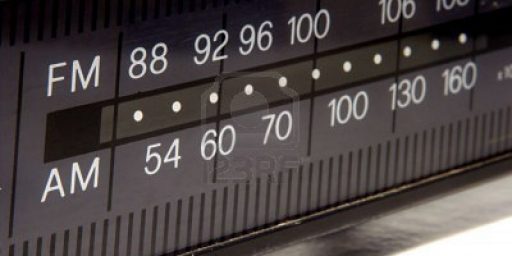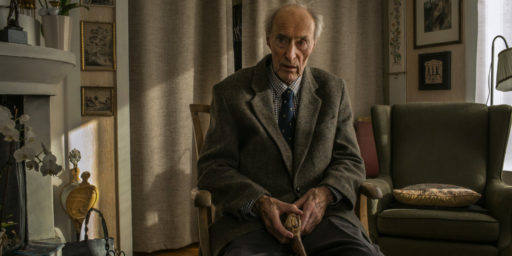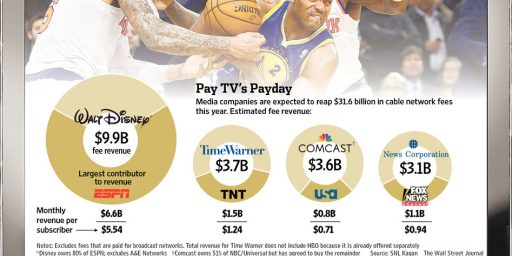Norway Phasing Out FM Radio By 2017
Norway is moving to all-digital radio.
Gizmodo (“Norway Will Be the First Country to Turn Off FM Radio in 2017“):
Norway’s Minister of Culture announced this week that a national FM-radio switch off will commence in 2017, allowing the country to complete its transition over to digital radio. It’s the end of an era.
As Radio.no notes, Digital Audio Broadcasting (DAB) will provide Norwegian listeners more diverse radio channel content than ever before. Indeed, DAB already hosts 22 national channels in Norway, as opposed to FM radio’s five, and a TNS Gallup survey shows that 56% of Norwegian listeners use digital radio every day. While Norway is the first country in the world to set a date for an FM switch-off, other countries in Europe and Southeast Asia are also in the process of transitioning to DAB.
According to Thor Gjermund Eriksen, head of the Norwegian Broadcasting Corporation: “This is an important day for everyone who loves radio. The minister’s decision allows us to concentrate our resources even more upon what is most important, namely to create high quality and diverse radio-content to our listeners.”
Frequency modulation, or FM, radio was patented in 1933 and has been recording and sharing the human story for nearly a century. But its days are clearly waning. According to a 2012 Pew Study, while over 90% of Americans still listen to AM/FM radio at least weekly, more people are choosing to forgo analog radio for Internet-only services each year.
Why Norway needs government intervention and a rapid transition away from the FM band is not obvious. I followed the link to the Radio.no report but it’s, as one might expect from a story that appears to be auto-translated into English, not much help. The only useful additional information is that, “Several countries in Europe and Southeast Asia, however, are in similar processes, choosing DAB-technology as the backbone of future radio distribution.” So, apparently there’s a trend.
I’ve tracked down the government’s press release, which gives this explanation:
Digitisation will also greatly improve the emergency preparedness system, facilitate increased competition and offer new opportunities for innovation and development,” says Minister of Culture Thorhild Widvey.
“Whereas the FM system only had space for five national channels, DAB already offers 22, and there is capacity for almost 20 more. In addition, more than half the population already has access to localradio on DAB, and there is considerable potential for further local channels,” she continues.
[…]
The cost of transmitting national radio channels through the FM- network is eight times higher than with the DAB-network, and P4, Radio Norge and NRK are currently spending large sums on parallel distribution. The digitalization of Norway’s national radio channels will realise savings of more than NOK 200 million a year, releasing funds for investment in radio content.
[…]
The DAB-network also offers clear advantages over the FM system from an emergency preparedness perspective. For one thing, DAB is far less vulnerable to transmitter failure in extreme conditions. Second, DAB permits tunnel reception of all channels. Finally, DAB technology allows simultaneous transmission of emergency messages on all channels.
I gather that Norway’s stations are privately-owned, so the government’s interests in their cost structure isn’t obvious. But there’s certainly an interest in improving the emergency system and advantage to be had in standardization of technology.
The UK, which of course maintains the government-owned BBC system, was contemplating such a move five years ago but balked at forcing consumers to replace their car radios. But most cars nowadays come with satellite radio installed.
I’m a longtime subscriber to satellite radio, which gives me more choices, but is still pretty lousy. I find the music channels poorly managed and only keep the subscription for news and sports programming. Both are infested with commercials, which is the main problem with over-the-air radio, so if there’s not a story I’m particularly interested in following I’ll often just switch to a podcast.






Spectrum is a scarce resource; a commons. Every nation regulates the use of specific frequency bands.
That’s really enough reason right there. Would you rather have highways that can only carry two lanes of traffic at 35 mph, or (with the same physical footprint) highways that can carry 16 lanes of traffic at 60 mph, with better safety and lower maintenance?
It’s really just the wireless broadcast version of the transition in telephony from reserved analog circuits to packets over a shared infrastructure.
@DrDaveT: I can understand the desire to promote the superior digital platform. I guess what I”m curious about is why the need to disband FM? Are they hoping to repurpose it? Or is it just to create more economies of scale for digital?
Lots of uses for the FM spectrum. It will most likely get repurposed for low power uses.
@James Joyner: Same thing in the U.S.: After the transition to digital television, T.V. Channels 2-6 & the upper ones (past 52 or so through 69) as well are available for mobile or low-power services.
And the FM broadcast band is located between former T.V. Channel 6 & still-used Channel 7. So you can imagine someone here will want it soon enough.
@James Joyner:
I had originally read the article as saying that the DAB would be implemented in the vacated FM band, but on re-reading I don’t see that stated explicitly anywhere. Since each FM frequency you phase out would support several new digital channels, you could do the transition in place over time.
If that’s not what they’re doing, then (as others have noted) there are lots of other uses. People pay big bucks for spectrum when it comes up for auction.